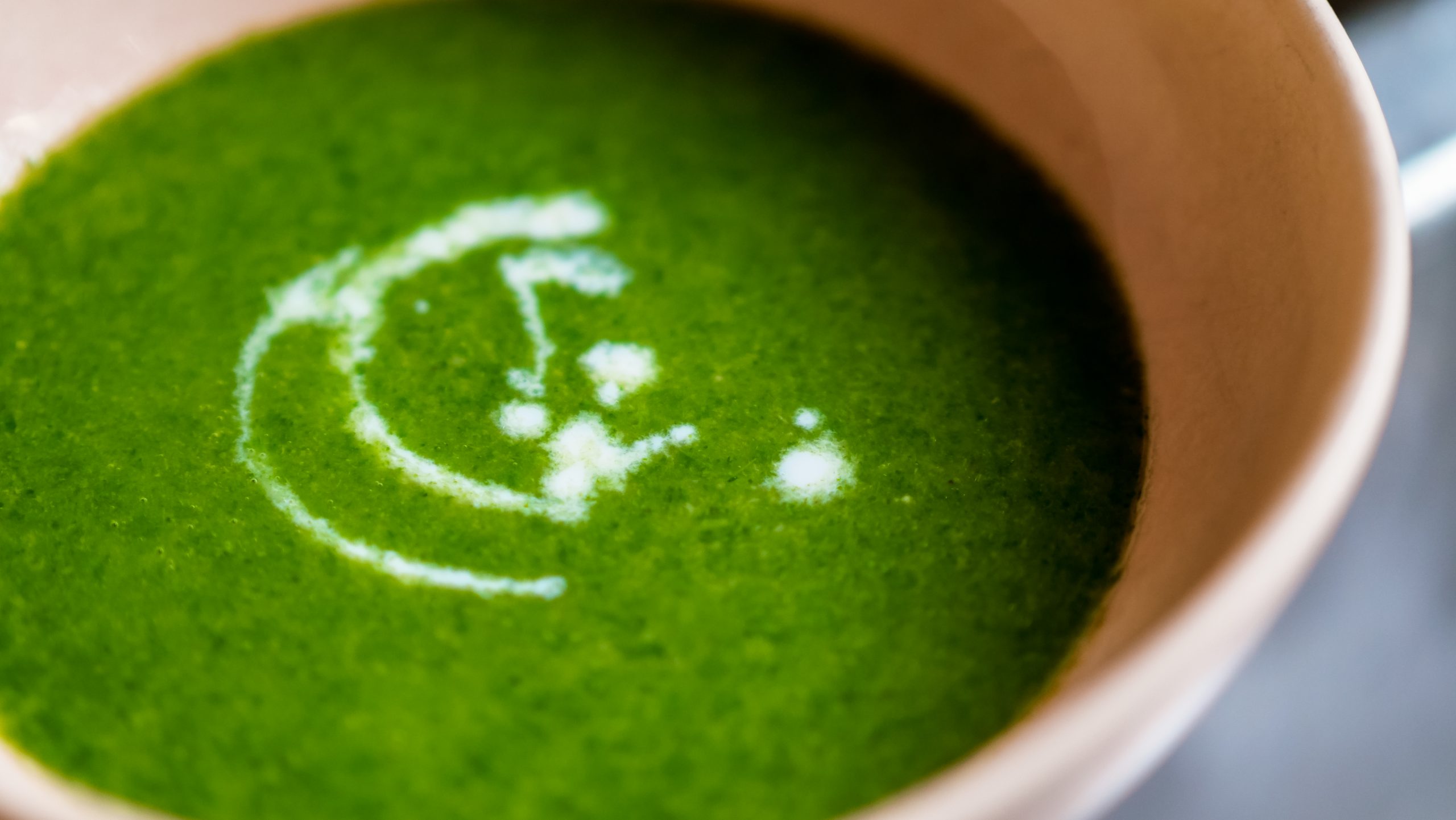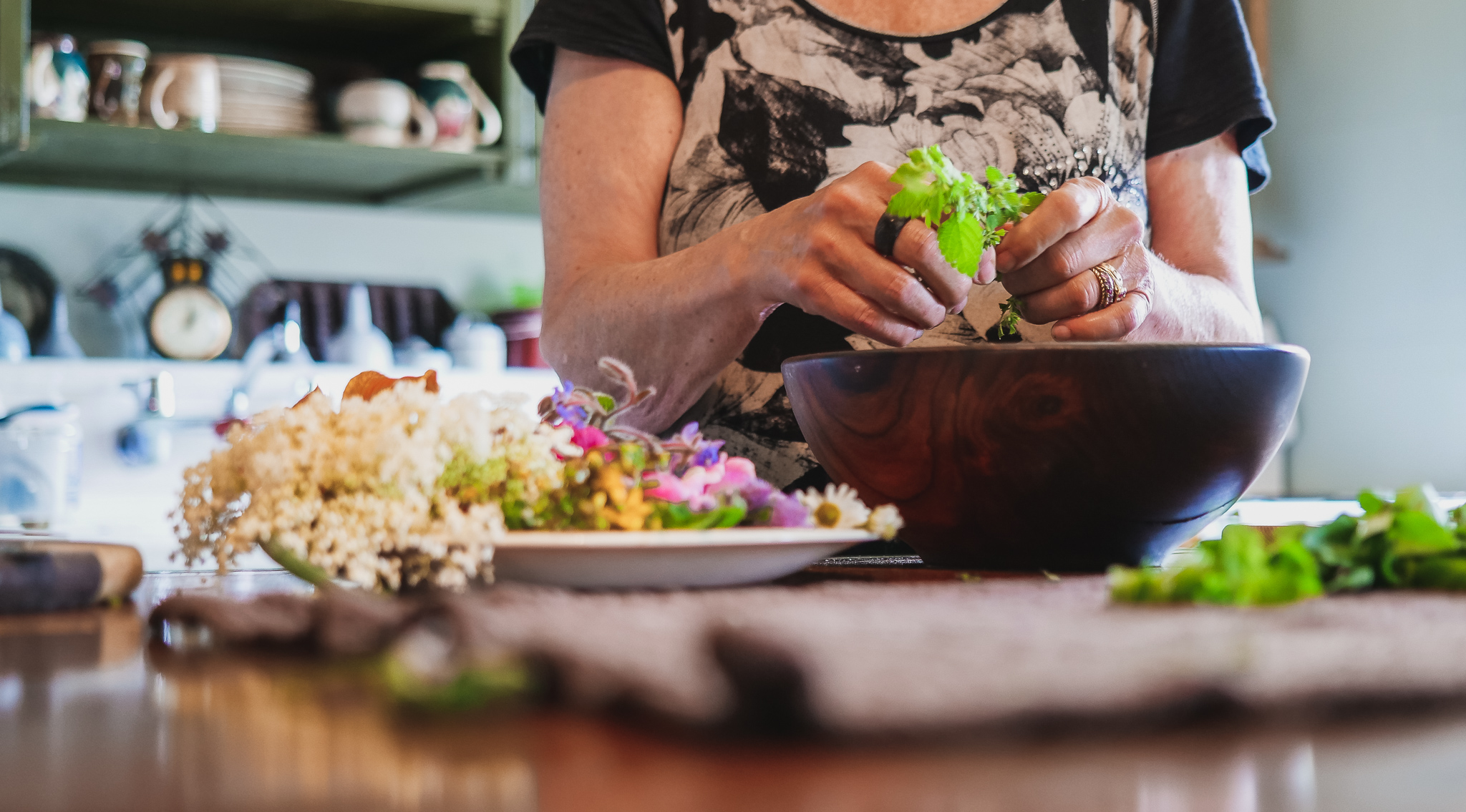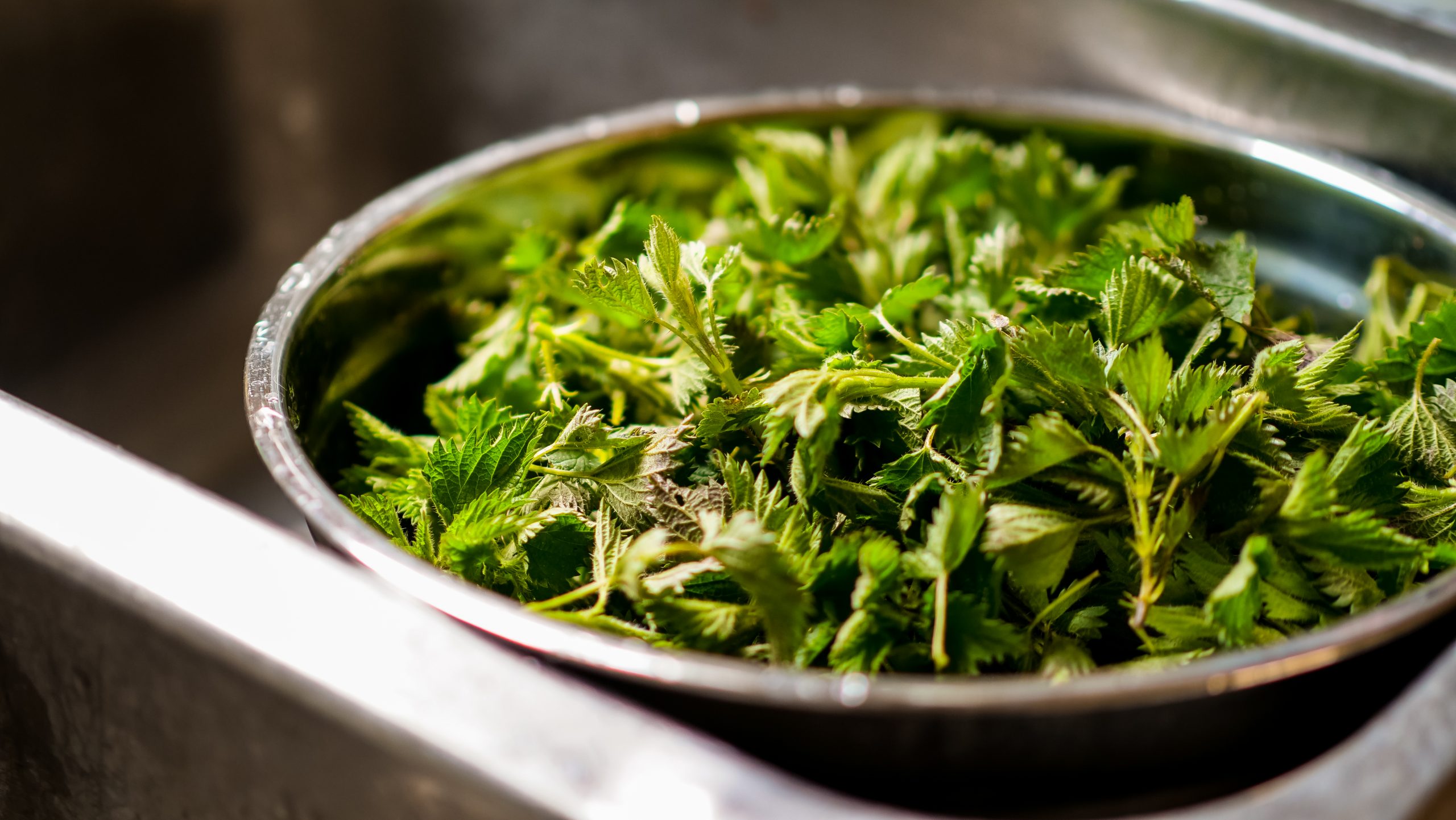An Interview with Pat Crocker
This interview was conducted as part of Everything Herbal’s ‘Herbal Elders’ series. This series seeks to honour and explore the unique contributions of longstanding members of the herbal medicine community in Canada, as well as abroad.
This interview was conducted with Nick Faunus, Penelope Beaudrow and Victor Cirone.
Everything Herbal: Tell us about yourself, and how you first became interested in working with healing foods and herbs.
Pat: I have been fascinated with food since I was young. We didn’t have Cola or candy of any kind in our house, so I learned at a very early age that if I wanted to feed my sweet tooth I had to learn to bake. So I baked everything! That is where my fascination with food started. I got focused on food when I went to university and knew that I was going to teach food and nutrition. After graduating, I taught high school students how to cook and then I segued into business, taking a leave of absence from teaching, to which I never went back. I freelanced for a variety of food companies, tested new products, wrote their copy, provided recipes. I then became interested in the area of food photography, and studied styling for food photography. Eventually I met up with another home economist who was freelancing and we realized that there was a better way than what the existing advertising agencies had going on, so we formed a public relations agency that focused specifically on food. We launched new products for companies like Heinz and Campbell’s soup; the conglomeration of Kraft foods didn’t exist at the time. Now there are only really one or two major food companies, but this is when they were all rather small.
When I met my husband and had a child, we moved to the country and I got focused and even more passionate about herbs and how herbs and food can affect healing. I took herbal medicine courses with a lot of great Canadian herbalists and started a little herb garden. We were living in a log cabin at the time, where I planted a herbal teaching garden, to which I invited many teachers. For 5 years we ran herb walks, going into the wild, down to the river. I was just down there the other day and I can’t believe all of the wild herbs that are thriving. Food and healing was always woven into whatever I was doing. Now I am introducing spirituality into my teachings and my writing because it is all coming together in a whole as mind/body/spirit.
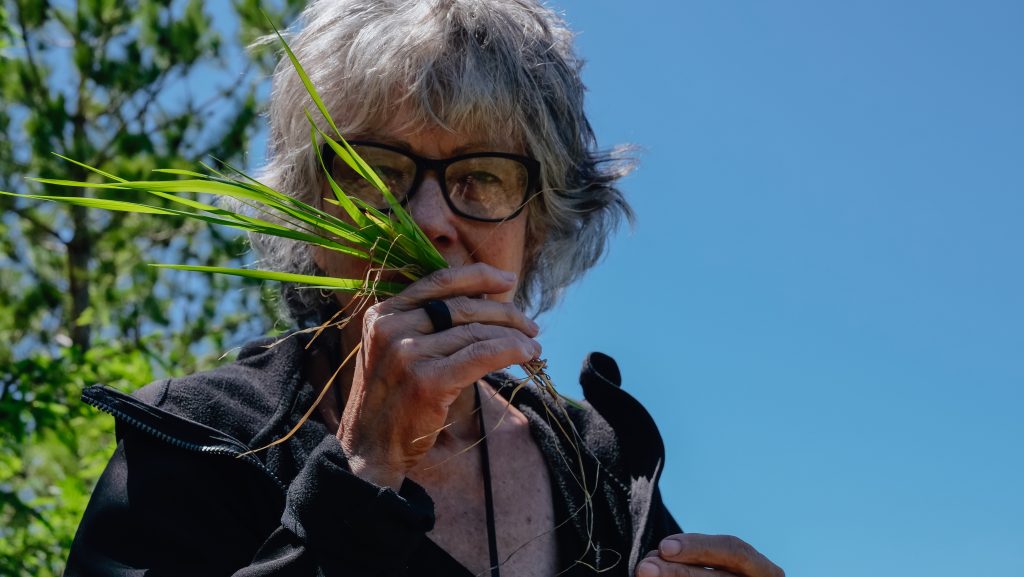
Pictured: Pat Crocker harvesting Sweet Grass
“It was and is so important for me to give back and be part of that herb and food community in whatever ways I can.”
Everything Herbal: Can you tell us about your involvement with the Ontario Herbalists Association?
Pat: When we moved to the country I still had a lot of strong bonds and ties to Toronto. I had been a member of the OHA for a long time, when Keith Stelling was putting out ‘The Canadian Journal of Herbalism’. I would provide material pertaining to herbs and food, practical application recipes for the journal. I also worked with John Redden when we were doing the Herb Fair. They were very heady days; when we were down at Ontario Place we would get what would seem like tens of thousands of people coming in. It was huge. Eventually I became the president of the OHA for a couple of years. When I was living in Toronto I was also president of the Ontario Home Economics Association. It was and is so important for me to give back and be part of that herb and food community in whatever ways I can.
Everything Herbal: Those of us who were working in the herbal industry shifted away from the herbal associations because they didn’t really focus on our needs. And today we don’t have a lot of power; we don’t have a lobby of any kind. We have dealings with the government all of the time but there isn’t really a voice to speak for us. Many of the associations relating to industry are there for seemingly cosmetic reasons. There were attempts to develop the professional side of the herbal associations but it never really took off. It all feels like a missed opportunity. How do you feel about these issues?
Pat: Greed got in the way; many people are oriented around the thought: ‘what’s in it for me’ rather than: ‘how can I meaningfully contribute to the industry?’ It is a missed opportunity, but the time might be coming back. We need younger people with energy. It is really a full time job to run an active association of any kind, and it requires money and resources, and a dedicated network of people.
Everything Herbal: What was the long term vision that you and others had when you were involved with the OHA? Are we there now?
Pat: It was so long ago and we weren’t really politicized at that time, except for Conrad Richter who was actively going to Ottawa. When things started to become political, I was in the process of pulling back and moving to the country, coming out of my term in office. When I was president we were focused on the herb fair, which helped to raise the profile of herbal medicine in Ontario. We had vendors coming from all over. I think it is time for herbalists to start thinking about launching similar public outreach efforts, to help raise the awareness of herbal medicine amongst the general population.
“That’s the advice I can give to anybody: dedicated, quality time for your work. Use your evenings for dreaming and scheming.”
Everything Herbal: You are the author of some 24 books. How have you been able to maintain your productive/creative life over all of these years? What sort of boundaries do you set for yourself so that you don’t become burnt out? Can you talk to us about the importance of self care practices?
Pat: You have to start with clarifying your intentions. What is it that I need? And how can I help others? These are the two intentions I always start with. Self-care has to include a spiritual component. I started out with a meditation practice but didn’t hit my stride with it. For the last 6 months, every single day, I do two hours of spiritual work with Caroline Myss. She started out as a medical intuitive, and her offerings have been deeply transformative for me. You need to find what works for you. Routine and dedication are important: I have a structure when I am writing, I get up at 6AM and work for two hours, then have breakfast and come back to work at 9. There are no interruptions; my email and phone are off, and I work for 4 more hours, and then I’m done. If you can get 4 hours of dedicated quality time that is all the time you really need to work, to get some good writing done. My energy is high in the mornings and it wanes throughout the day, so I work with it rather than against it. I can leave all of the shopping and cooking and the telephone calls for the afternoon. That’s the advice I can give to anybody: dedicated, quality time for your work. Use your evenings for dreaming and scheming.
Everything Herbal: Tell us about the content of your books for those who are unfamiliar with them. What are you working on now, and how has your writing evolved over the years?
Pat: ‘Riversong’ is the book that came out of my time in the cabin, where all of the herb walks took place. That was the first book, which was a product of serendipity. My husband is an illustrator and he was called down to a meeting in Toronto. There was a new publisher who was just starting out and who had asked my husband to illustrate a children’s book. As chance had it, this publisher was also looking for cookbook authors, and so the door was opened for me. This first book was called ‘Riversong’ because the Saugeen River runs through the 18 acres where our cabin was situated. ‘The Healing Herbs Cookbook’ was my second title, which presented the recipes that I had developed from the herb walks. The concept I had was to actually talk about each herb at the beginning of the book in some detail. That quickly became the format for most of my books: I talk about the herb or the food, give a useful description, talk about the taste and flavour profile, the parts used, and the healing properties. ‘The Herbalist’s Kitchen’ came out in 2020, and it has even more of a focus on herbs than any of my previous books do. There I go into a lot of information on each herb. By the time I wrote ‘The Herbalist’s Kitchen’ I had been travelling and visiting many gardens, photographing herbs and herb gardens, and these photos made their way into the book. Now what I would like to do is focus in on the spiritual aspect of eating, and how discipline in eating can help you with discipline in your spiritual practice, or vice versa. The two go together. This is the area that I would like to serve now.
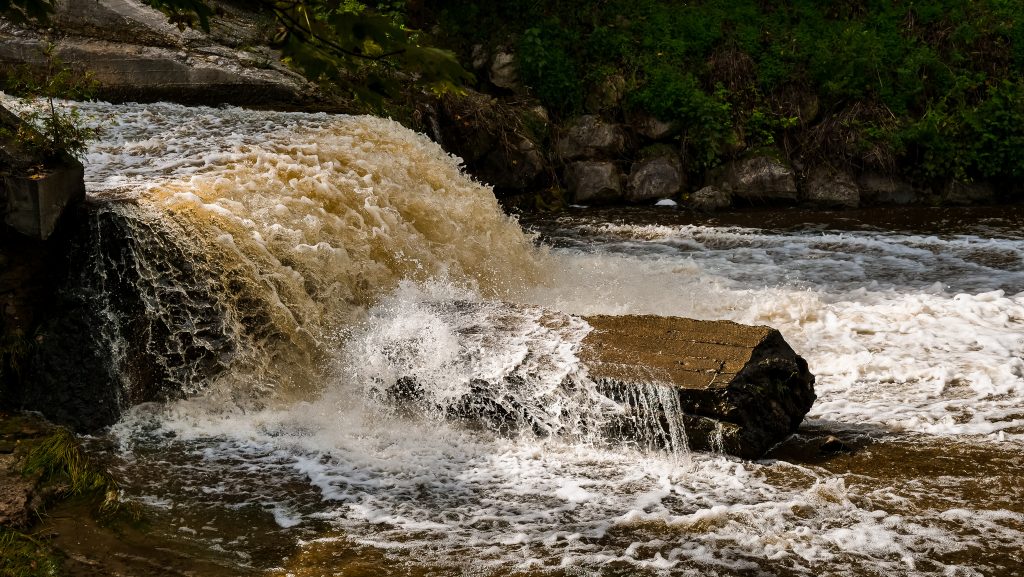
Pictured: Riversong Suites’ Waterfall
Let your food be your medicine…
Everything Herbal: We always come back to Hippocrates: let your food be your medicine. Life, food and spirit are inextricably connected, and there are so many traditions globally which emphasize the importance that our dietary choices have to our spiritual development, both individually and collectively. Fasting also has major spiritual significance for many. Fasting is a cleansing process, physical and emotions toxins can come to the surface during a fast, and having to face what has been buried is, in a way, a kind of shamanic practice.
Pat: The book that I am working on now starts by describing a 42 day way of eating that acts as a fast that serves to break old habits. My husband and I did it last year and it took me off thyroid drugs and high blood pressure drugs. My husband had a kind of itchy rash that looked like rosacea, it was starting to cover his whole body, and that is now gone too. I’ve also seen this fast help greatly with arthritis. This book will describe this fasting process in detail, which is basically no meat, dairy, no added oils in cooking, basically just fruit, vegetables, nuts and seeds. When it is done properly it is amazing. The discipline you get from doing that strengthens the discipline you need for spiritual practice, whether it is meditation or whatever form your practice takes. The two strengthen each other.
Everything Herbal: Food and lifestyle considerations have always been a part of spirituality. We can look to the intersection of Yoga and Ayurveda as a very clear example. Many people who are involved in yoga today have forgotten about this, as yoga has become a glorified fitness system. But the fact that Yoga and Ayurveda are sister sciences is starting to come into focus, as many people who have been engaged in yoga as an athletic practice are starting to realize that something is missing from what they are doing. Many ancient traditions respect and embody what you are describing, but the intricacies have been lost because of how things have been marketed and sold to people.
Pat: There is a lot of discussion about epigenetics in today’s food and nutrition world, concerning how our genes are affected by our thoughts, and how this controls our form. The connection between bad food and our negative thought forms is becoming clear to many. Sugars and additives, artificial chemicals and fillers in particular, actually block us from being able to discern truth, from being able to discern right from wrong. The toxins in our foods lock us into a viscous circle, and generate strong desires, cravings, and even a need for more and more bad food. When we are trapped in this way, it becomes difficult if not impossible for us to realize and become clear with our intentions, to learn to think for ourselves and step into our own power. What and how we eat has so much to do with this.
“Science is now catching up to what many of our spiritual traditions have been saying for thousands of years now.”
Everything Herbal: As we now know, the human body has an enteric nervous system, a network of nerves, neurons and neurotransmitters which extends along the entire digestive tract; basically, a second brain housed in the gut.
Pat: This is why people have always said ‘I just feel it in my gut.’ Intuitively, we’ve known this for countless generations. Science is now catching up to what many of our spiritual traditions have been saying for thousands of years now.
Everything Herbal: What are some important lessons that you think herbal elders should convey to the current generation of herbalists that are doing their training and just starting to practice?
Pat: We know where we have been, we need to look forward to where we are going. We are moving towards community, towards global cooperation. We are just now as a species understanding that what we do to one we do to the whole. We all breathe together. My advice to younger herbalists is to think about how they fit in to the emerging pattern of the global community, and what their role is when it comes to serving that larger sense of a cooperative and sustainable future. Herbalists are uniquely poised to understand this concept, it is inherent in the work that we do. We get this message of interdependence because we are so connected to nature. The herbalists who are coming up into the world now need to carry this torch a little further.
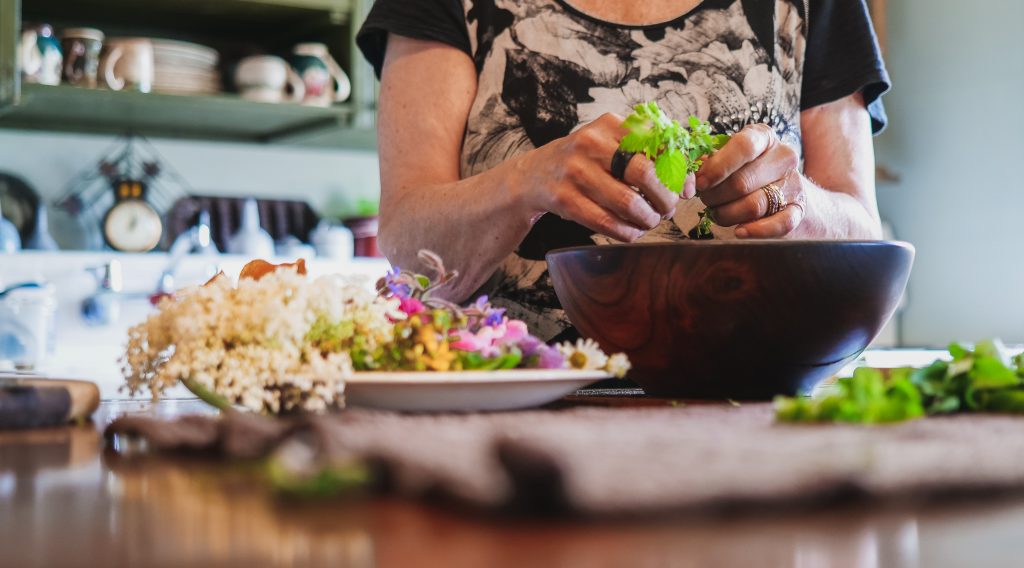
Pictured: Pat putting together a wildcrafted salad with assorted flowers and herbs.
“Much of the work that I do involves stepping into the Wise Woman archetype…”
Everything Herbal: Can you tell us more about your vision of how herbal medicine fits into planetary ecology?
Pat: If we look at the world today from an archetypal perspective, one thing that clearly stands out is that we are experiencing global pandemic. It is not a coincidence that this pandemic affects our respiratory system. What are we doing as human beings? We are cutting down the lungs of the planet. We are slashing and burning the lungs of the Earth. To me, it is as blatant as the noses on our faces that we are now having to face our collective karma. What we do now is going to affect us and our collective future in so many profound ways. We really don’t have a lot of time to get things sorted. My vision is that we are moving from Homo sapiens to Homo luminous. To get there we’ve got to raise our consciousness from the physical, nuclear weaponry level to the level of regenerative archetypes, which we must learn how to step into and embody. Much of the work that I do involves stepping into the Wise Woman archetype, in an effort to help raise the consciousness of those around me. Herbalists can lead the charge in this direction, towards really making the connection between what we do in our own households, in our neighbourhoods, in our towns and cities – and how this affects the whole.
Everything Herbal: We need to address longstanding patterns of human behaviour, and this pandemic is a vital turning point. There are no coincidences. The pandemic is a portal.
Pat: The pandemic gave many of us in the Western world the time and space to reflect, we were forced to stop what we were doing. We were given time to devote to our spiritual practices, to reflect on what we were doing personally, it was time to disrupt and call into question our old and outdated habits and modes of thinking.
Everything Herbal: There are so many young people today who are plagued with crippling anxiety, and the pandemic has served to shine a light on this too.
Pat: Many people have been anxious their whole lives and they didn’t know it. Anxiety can manifest as weird behaviour and unusual decision making patterns. I am starting to realize that millennials, people born 20 – 40 years ago, were born with an open, intuitive energy system. They absorbed all of the energy that their parents were carrying. I never did that, I was in my own little world. What my parents were doing didn’t so greatly affect me. But every little nuance in my life affected my daughter, for example. We need to recalibrate and figure out how to move from being 5 sensory to multi sensory human beings. That is where we are going, and it is an uphill learning curve. Younger generations have come into the world with their energy systems open, and this is one of the main reasons behind the epidemic of anxiety that many young people are living out from today. The younger generation need more tools to recognize this situation, and have to learn to navigate it in such a way that leads to a regenerative future.
“We have to find a way to live in harmony”
Everything Herbal: Anxiety is often rooted in uncertainty and fear. And we live in an environment where everything is uncertain. The toxic environment poisoned food that we were discussing earlier is the prefect breeding ground for an epidemic of anxiety.
Pat: When we entered the nuclear age, that changed absolutely everything. Civilization has now come to a point where we can destroy ourselves. We can’t run away from that. We can’t get away. There is nothing we can create that will change this fact. We have to find a way to live in harmony and restore the planet before we blow ourselves up.
Everything Herbal: We need to be better people, don’t we.
Pat: Yes we do.
Everything Herbal: Coming back to the Wise Woman archetype, one of the things that we are seeing a lot of today in the herbal medicine world is the hyper-sexualization of women’s bodies as a means of generating attention and selling products and services. What are your thoughts on this phenomenon?
Pat: There is a deep incongruence that comes through in the situation you’ve just described. Culturally we are still teaching that women are sexual objects, advertising and cultural production is still stuck in that paradigm. There are many generations of accumulated religious and cultural guilt that we have been brought up in and that we are still holding on to. We exist in a legacy of the oppression of women and women’s sexuality, and this legacy goes back thousands of years. Until those images, until this whole cultural messaging system changes, it is likely that we are still going to have young women growing up thinking that the only way that they can hold any kind of power is to sexualize themselves.
Everything Herbal: It is important to emphasize the notion of the image; images have deep unconscious resonance patterns that they inflict upon us when we are exposed to them. The digital imaginary has only deepened our collective repressed fantasy life; collective repression is now being orchestrated on a massive scale through a regime of unwholesome, unlawful images. People are searching for meaning in a seemingly nihilistic world, and outwardly projected, programmed images are what is immediately available to them. But true meaning comes from inner pictures, from images that have their source in the soul.
Pat: That is one of our primary tasks going forward, learning to understand and harness our true power, which comes from within.
To learn more about Pat and her work, visit her online at: www.patcrocker.com
–
Photos provided by Serena Mor
Hot Chiles Bite Winter Back
Chile Pepper Medicine Turns Up the Heat
While on the quest for the shortest route to the East, Spanish navigators discovered the hot and fiery chile pepper. Abundant and adored by Caribbean natives, the conquistadors called it pimiento, the Spanish word for pepper.
Capsaicinoids are the naturally occurring compounds that give chile peppers pungency and heat. Every type of pepper has a unique taste – from slightly floral, fruity, sweet, and spicy to pungent – and each type has a heat rating that is based on the kind and intensity of the capsaicin it contains. For example, peppers that contain only nordihydrocapsaicin (NDHC) will present a mellow, warming effect that recedes quickly and lingers briefly at the front of the mouth. In contrast, the explosive heat and pungency of pomodihydrocapsaicin (HDHC) produces a strong numbing, burning sensation in the throat and back of the tongue that is more intense and lasts longer.
Chile heads (lovers of hot peppers) have long known that the hotter the chile pepper (and the more capsaicin it contains), the greater will be the endorphin rush they experience. Endorphins are produced by the pituitary gland and the hypothalamus – when released they cause a positive feeling in the body, similar to that of morphine. By triggering endorphins, capsaicins work as natural painkillers along with boosting memory function.

How to Gauge the Heat
Want to eat more chiles but are afraid of their blazing bite? I have two tips for helping you enjoy the incredible benefits of chiles.
First, get familiar with the Scoville Heat Unit (SHU) system of measuring the heat in chile peppers. The Scoville Scale is a standard measurement of the concentration of capsaicin (the constituent that causes the skin and mouth to tingle or burn) in every type of pepper and assigns it a number from 0 to 5 million.
Secondly, start cooking with peppers that are low on the Scoville scale and begin to work your way towards a higher rated pepper. Sweet bell pepper types rate 0 to 1000 Scoville Units, which means that they are delicious (red bell peppers are sweeter than green), with no discernable burning, but are not high in capsaicin. Hungarian paprika is only slightly hotter, with 1,500 units, but it imparts an apple note that is perfect for stew and goulash dishes, or in vegetable stir-fries. Poblano chiles and New Mexican types move up the scale to 7,000 SHU and are roasted or stuffed and baked for a mildly hot experience that dissipates quickly.
My goal, when I began to grow, buy, and cook with chile peppers was to become comfortable eating cayenne peppers, which flare from 30,000 to 50,000 SHU. This is a reasonable goal because we enjoy significant health benefits from adding one fresh (or dried) cayenne pepper to smoothies, soups, stews, stir-fries, or other dishes at least three times per week.
I’m happy to say that it didn’t take long before I was sizzling my way up to Habanero type peppers, which register between 80,000 and 150,000 SHU. Then my friends at Shady Acres Herb farm in Minnesota sent me some Bhut Joloka (aka Ghost) chiles that they had grown. Although Carolina Reaper chiles register higher in SHU (1,600,000 to 2,200,000 SHU), Ghost chiles are still considered to be incendiary, combusting at 855,000 to 2,199,999 SHU. I dried my cache of Ghost red hots and sometimes, when I am feeling adventurous, I slip on a pair of disposable gloves, snip off a quarter-inch piece of that phantom pepper and dice it into teeny granules which then get added to a chowder or curry dish. It never fails to deliver the famous chile-rush.
Health Benefits of Cayenne
Being exceptionally high in vitamin A, which acts as an antioxidant to help fight aging and cell damage, cayenne peppers, and all others above or below them on the Scoville Heat scale, deliver an incredible array of healing gifts. Buy or grow them and use fresh, or dry and crumble them into all kinds of dishes.
Here is what you can ignite once you begin to enjoy the cayenne conflagration:
- Anti-inflammatory action – reduces the pain and swelling of arthritis. Cayenne cream or salve is applied topically to treat arthritis and muscle pain
- Lowers cholesterol – and triglyceride levels for heart health
- Fights bacteria and viruses – with its high vitamin C content
- Increases circulation – by improving blood flow and stimulating sweating (an important process of detoxification). A tea made of warm water, lemon juice, and cayenne pepper is an excellent morning beverage for total body health
- Anti-fungal properties – soak feet in warm water with one tablespoon powdered cayenne pepper to help alleviate athlete’s foot
- Aids digestion – capsaicin stimulates the digestive tract and may give relief to people suffering from peptic ulcers by stimulating blood flow that nourishes the gastric mucosal membrane
- Helps relieve allergies – and acts as a decongestant by stimulating the release of mucus from respiratory passages
- Reduces blood clots – and can be used as a first response for wounds to stop bleeding
How about you? What varieties are you eating or using to make medicine?
Watch for my next post, Cooking with Cayenne. Meantime, here are some recipes that will warm and soothe:
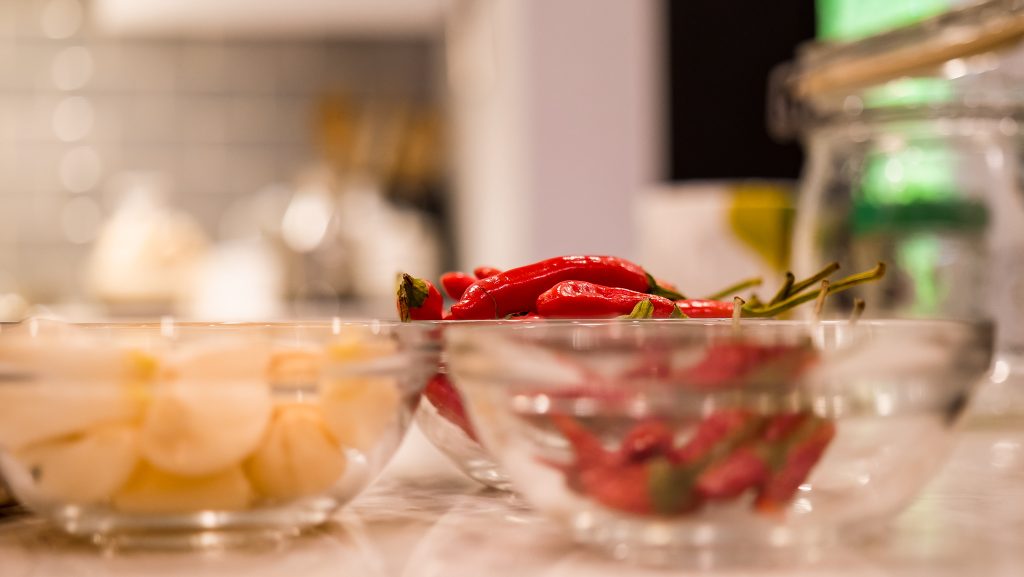
Harissa
A key flavouring and condiment in Middle Eastern and North African cuisine, Harissa is never far from a Moroccan, Libyan, Algerian, Turkish, or Tunisian table. In fact, it is the go-to seasoning for many cooks in the region. Often it is added to soup, stew and curry dishes or tagines, used with meatballs, or rubbed into kebabs and other meats before grilling. The main ingredient is cayenne (or other hot chile peppers) and while it is easy to make from fresh or dried hot chiles, it is also widely available in cans or tubes, or freshly prepared in tubs in Middle Eastern or North African markets.
Dairy products (in particular yogurt), and the starch in pastas and couscous, help to dial the heat down and so they are often paired with harissa and other hot chile dishes.
(Makes 1/2 cup)
Ingredients:
- 12 cayenne, serano, or jalapeno chile peppers, fresh or dried
- 3/4 cup boiled water
- 1 tablespoon cumin seeds
- 2 teaspoons coriander seeds
- 1 teaspoon fennel seeds
- 1 piece (2-inch) cinnamon, crushed
- 1/2 teaspoon fenugreek seeds, optional
- 2 cloves garlic
- 1/2 teaspoon sea salt
- 1/2 cup extra-virgin olive oil
Method:
Discard stems and seeds from the chiles. Using kitchen scissors, cut chiles crosswise into thin strips, letting them fall into a bowl. Pour water over top and soak for 30 minutes or until softened.
Meanwhile, in a small, heavy pan or spice wok, over medium heat, dry-fry cumin, coriander, fennel, cinnamon, and fenugreek seeds (optional) for three minutes, or until fragrant and light brown. Set aside to cool.
Using a small food processor or blender, chop the garlic with the salt. Drain chiles, discarding the soaking water (or reserving it for another use later). Add chiles to garlic and process until smooth. Add toasted spices and process to incorporate them into the mixture.
With the motor running, gradually drizzle in the oil through the opening in the lid, processing the mixture until the sauce is well blended to a consistency of mayonnaise.
Pat’s Cayenne Fire Cider
The name sounds daring, and the brew is ablaze with the energy of healing ingredients. This natural sinus, cold and ‘flu folk remedy has been home-brewed for eons by herbalists, naturalists, and anyone who has learned of its efficacy. Grated horseradish root, garlic, onion, ginger, and hot peppers are the main ingredients that are steeped in organic unpasteurized apple cider vinegar, but you can develop your own amounts and combinations. Before my horseradish plant grew large enough for me to actually dig the roots, I developed the following simple and very potent blend. Now I add the horseradish, but you can omit it if you can’t find fresh root.
See the Resources section for a link to herbalist Rosemary Gladstar’s Fire Cider method [2] and visit the Mountain Rose Blog [3] to read about this well-known herb supplier’s Fire Cider.
(Makes about 4 cups)
Ingredients:
- 25 whole fresh cayenne peppers
- 1 head garlic cloves, peeled and sliced
- 1 cup fresh ginger, grated
- 3 – 4 cups raw unfiltered apple cider vinegar
- Optional Ingredients
- 2 cups grated fresh horseradish
- 6 sprigs fresh rosemary, horehound, thyme, sage, parsley
- 2 onions, chopped
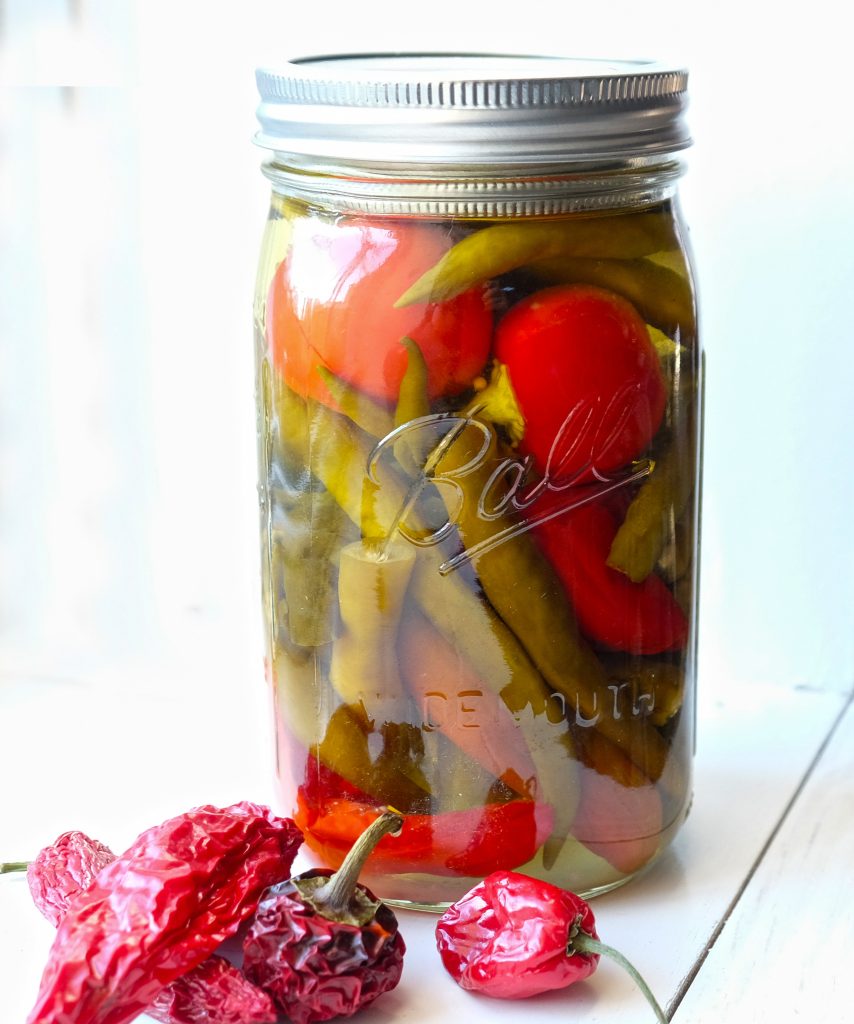
Method:
Clean and slit or halve the peppers. Loosely pack them into a one quart mason-style jar. Add garlic slices and ginger. Add horseradish and other optional ingredients, if using.
Fill the jar, covering the ingredients with vinegar, leaving a half-inch space.
Make sure the peppers are below the vinegar, and cap the jar with the 2-piece lid. Set aside in a cool, dark cupboard for a month or longer.
After steeping the ingredients, you can refrigerate the jar (although it isn’t required). If you don’t strain the vinegar, you can fish out, drain and use the chiles, garlic slices, and ginger in recipes until they are finished. Alternately, you can strain the vinegar and make syrup as follows.
To make a cough syrup: Strain the steeped vinegar into a 6-cup measuring cup, pressing on the solids to extract as much vinegar as possible. Discard the solids.
For every cup of strained vinegar, add 1/4 – 1/2 cup (to taste) liquid honey. Stir well or heat over low setting in a saucepan to melt and combine the honey. Pour into 1-cup jars, cap, label, and store in a cool, dark cupboard.
Serving suggestions for unsweetened steeped vinegar:
- Take one tablespoon of vinegar in a glass of warm water with one to two teaspoons of honey every morning for its tonic benefits.
- Substituting steeped vinegar in recipes that call for regular vinegar (salad dressing, dips, spreads, sauces, and other condiments) will infuse them with the healing benefits of Fire Cider.
- Cough Syrup: Take one tablespoon at the first sign of a cold and repeat every two to three hours until symptoms subside.
Resources
[1] Tucker, Art and Thomas De Baggio, The Encyclopedia of Herbs. Portland, OR: Timber Press, 2009
[2] Rosemary Gladstar, video of her Fire Cider method
Pat Crocker cultivates cayenne and turns up the heat in recipes. Her newest book, The Herbalist’s Kitchen is available on her website and at all major bookstores. Photographer, lecturer, and author of several award-winning books, including Coconut 24/7, Preserving, The Vegan Cook’s Bible, The Vegetarian Cook’s Bible, The Healing Herbs Cookbook, The Juicing Bible, and The Smoothies Bible, Pat would love to hear from you about your personal adventures with herbs. www.patcrocker.com
Blog photos provided by Pat Crocker
Header photo provided by Serena Mor
Cooking with Herbs: Stinging Nettle Soup
Recipe
- 1 lb/450 g or more of Stinging Nettles (young tender shoots preferably harvested in early spring)
- 1 tsp salt
- 1 tbsp olive oil
- 1 onion
- 1/2 cup uncooked basmati rice
- 8 cups vegetable broth stock (or use 2 organic vegetable bouillon cubes)
- More salt and pepper to taste
- Garnish: cashew nut cream or regular cream (optional)
Method
1) Wearing latex/rubber gloves sort out the harvested stinging nettles and remove any thick stems.

2) Wash the stinging nettles and drain.
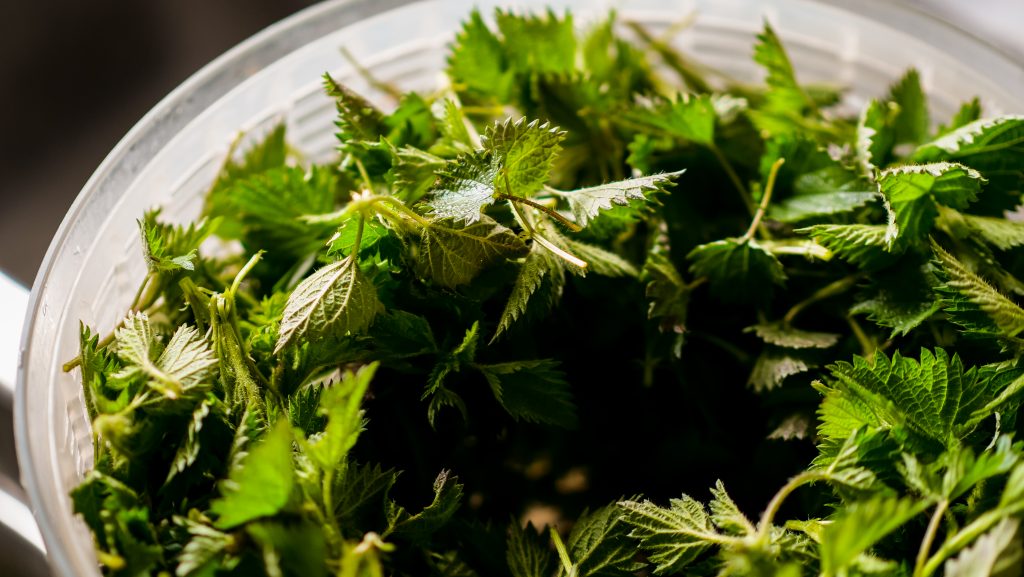
3) Bring a large pot of water to a boil with 1 tsp of salt added. Blanch the stinging nettles in the boiling water for about 2 minutes. This will remove the sting so you can chop it.
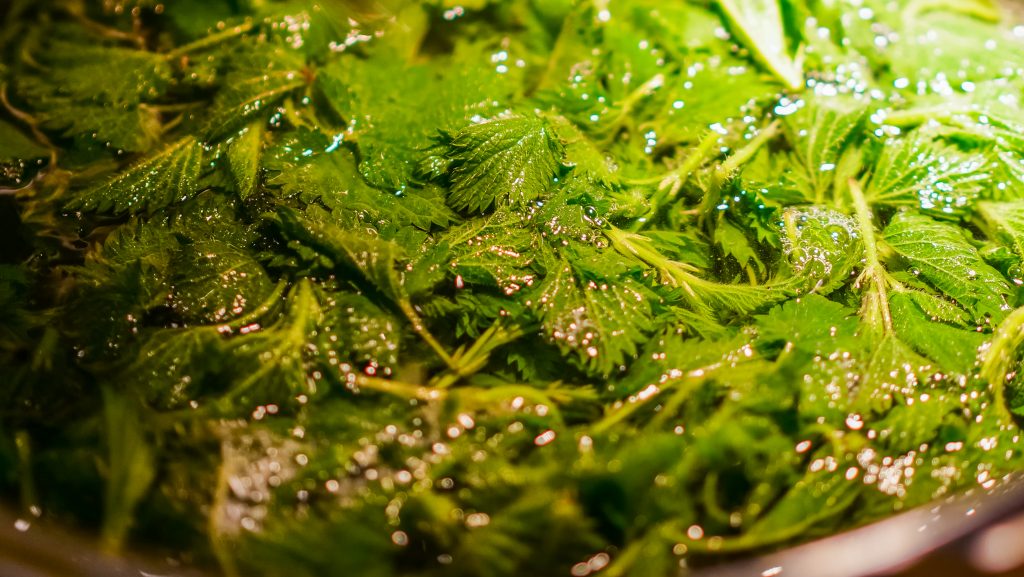
Use a large spoon strainer to remove nettles from the pot. Put them in a colander and run cold water over it to cool it down.
Do not drain the nettle water, reserve it to make your vegetable stock broth.
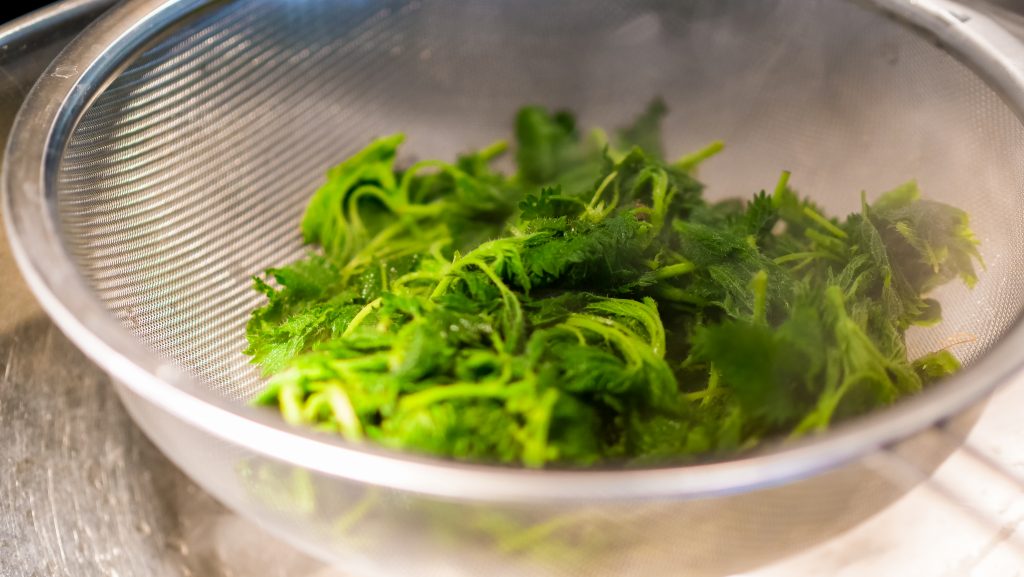
4) Fry a chopped onion in the pot. Add the reserved nettle water along with two stock cubes.
Bring to a boil and add the rinsed basmati rice. Always rinse your basmati rice a few times with water until the water is clear.
Add rice to the pot and simmer for 8-10 minutes.
5) Now add the chopped stinging nettles. Simmer for about 5 minutes, do not overcook this nutritious pot herb. Add ground black pepper to taste. You may not need to add more salt.
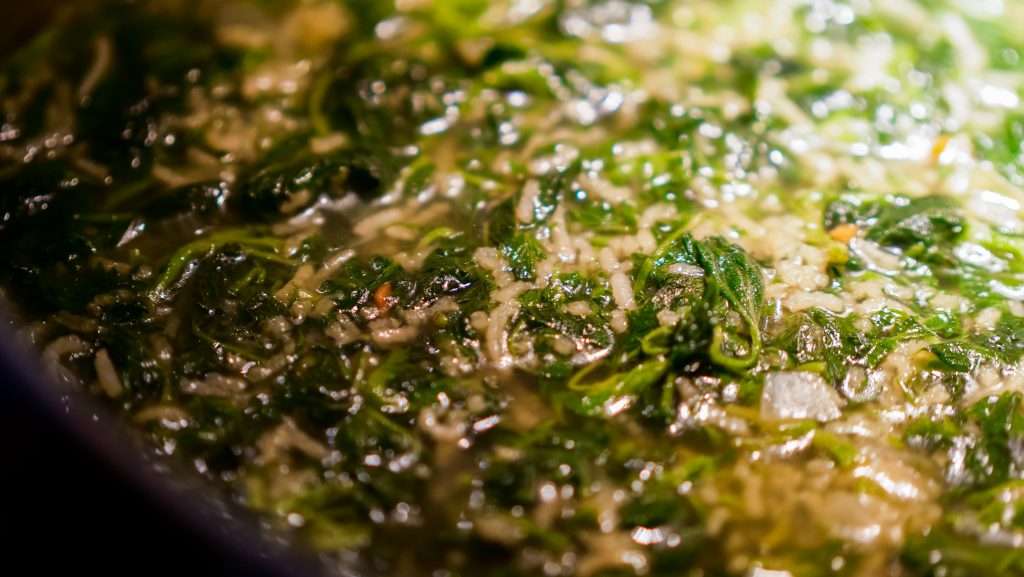
6) Turn off the heat. Using an immersion blender puree the soup. You can enjoy this soup with or without cream served in the bowl.
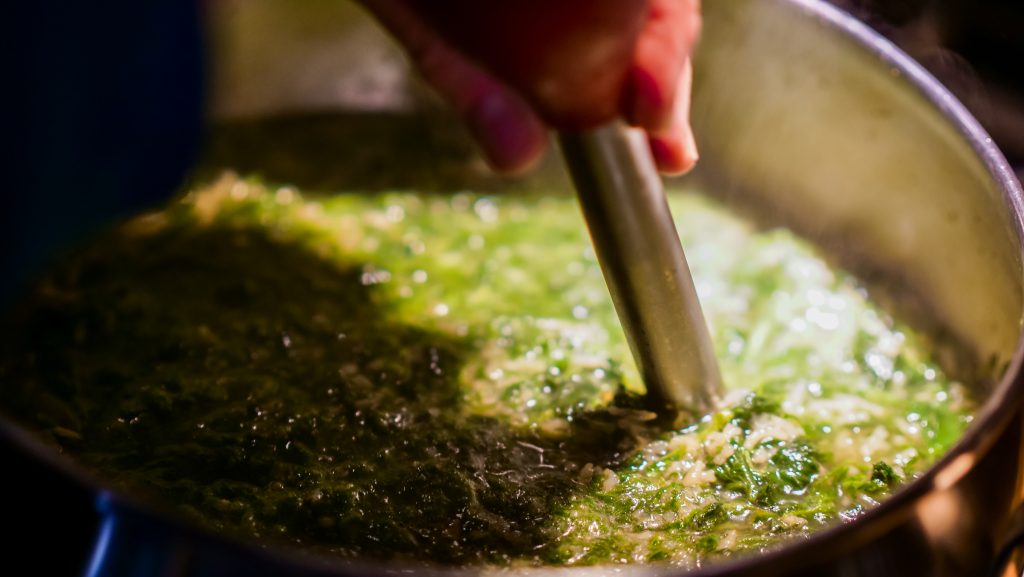
Enjoy!
– Recipe contributed by Karin M
Did You Know?
- The botanical name for Stinging Nettle is Urtica Diocia
- Nettles are a Nutritive (a class of plants that are rich in vitamins and minerals; a source of easily assimilated nutrients. Ideal for those suffering with anemia.)
- Cooked nettles are both salty and sweet. The stronger, salty flavor indicates the high level of minerals and the sweet flavor encompasses elements that build up tissues and strengthen the body.
